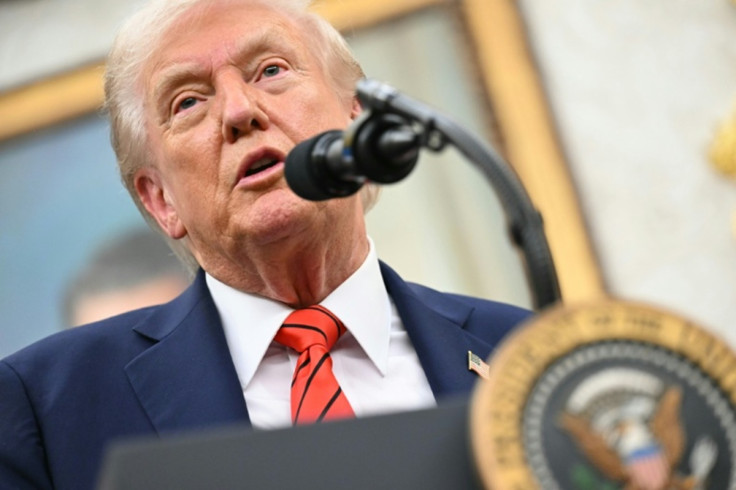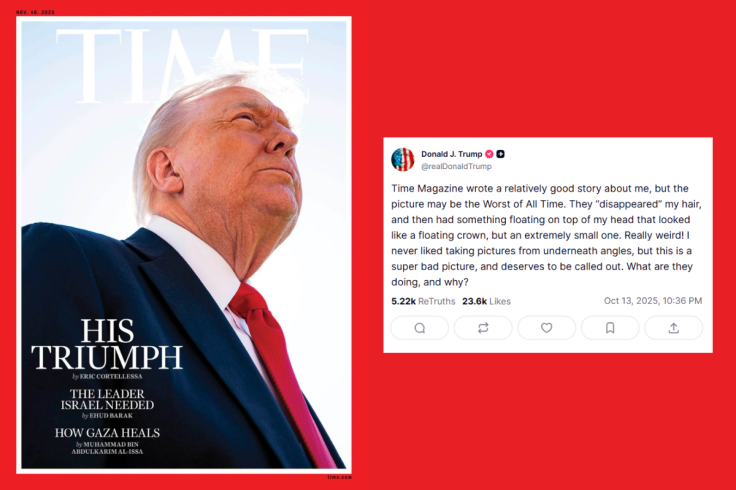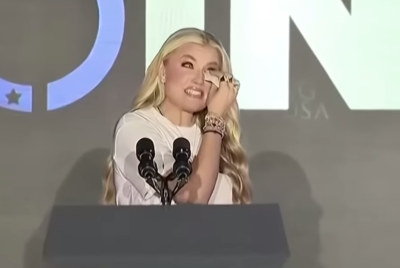Was Time Magazine Cover of Trump Photoshopped To Make Him Look Bad? Reactions After US President Declares It 'The Worst Of All Time'
Trump claims editors erased his hair and added a 'floating crown'

When Time magazine revealed its 10 November 2025 issue featuring Donald Trump, public attention quickly shifted from the article to the photograph. The cover, accompanying a feature on his role in brokering a ceasefire between Israel and Gaza, showed the US president framed by a bright halo of light.
Within hours, Trump posted on Truth Social, describing the image as 'the worst of all time'. He claimed editors had erased his hair and placed a 'floating crown' above his head.
The comments reignited debate about how political figures are portrayed in the media, prompting questions over whether Time deliberately altered the image or if Trump's reaction reflected his well-known sensitivity to visual depictions of himself.
What Trump Claimed and What the Cover Shows
In his online post, Trump praised Time's story but criticised the image. 'They disappeared my hair, and then had something floating on top of my head that looked like a floating crown, but an extremely small one. Really weird!' he wrote. 'I never liked taking pictures from underneath angles, but this is a super bad picture, and deserves to be called out.'

The cover photograph shows Trump from a low angle, with sunlight behind him creating a halo-style glow around his hair. Photography analysts told The Washington Post that this kind of lighting can wash out fine details, making edges appear softer. Some viewers noted a crown-shaped light flare, which Trump claimed was deliberate, though experts say the effect was optical rather than edited.
So far, no independent review has found evidence that the image was intentionally manipulated to make Trump look worse. The Getty Images version appears identical to the published cover, with only routine adjustments to brightness, contrast and cropping.
Expert Views and Media Analysis
Specialists note that editorial retouching is routine in magazine production. Adjustments to exposure, colour balance and shadows are standard practice intended to improve clarity. The New York Magazine Intelligencer reported that Time's image appeared consistent with a recent Getty portrait and that any editing was typical of magazine publishing.
Time has not commented publicly on the controversy. Several outlets, including Axios and Forbes, observed that Trump has a history of objecting to depictions he considers unflattering, from paintings to magazine covers.
International reaction has also surfaced. Russia's foreign-ministry spokesperson Maria Zakharova criticised the cover as 'astonishing', suggesting it was politically motivated, according to The Guardian.
Time magazine often uses agency photographs for its covers rather than bespoke shoots, a practice that can intensify scrutiny of lighting or composition choices.
The living Israeli hostages held in Gaza have been freed under the first phase of Donald Trump's peace plan, alongside a Palestinian prisoner release. The deal may become a signature achievement of Trump's second term, and it could mark a strategic turning point for the Middle… pic.twitter.com/0bZDABIDGj
— TIME (@TIME) October 13, 2025
Why such an odd angle? Thought you employed the best photographers in the world. 🤦🏻♀️ This one is much, much better pic.twitter.com/NTED464IMa
— wyregal 🇺🇸🇺🇸🐊☀️🌴🍊🏴☠️🇺🇸🇺🇸 (@wyregal) October 13, 2025
You creeps had to use a terrible photo from a terrible angle. Petty losers.
— Rita Panahi (@RitaPanahi) October 13, 2025
Every photographer knows that this angle is the worst and you used it anyways. This was on purpose.
— Sarah Fields (@SarahisCensored) October 14, 2025
Time manages to use a photo that renders the president almost unrecognizable despite
— Christine (@Christine726508) October 13, 2025
Him being the most photogenic president with the most iconic images ever. Douche bags.
You can keep your backhanded insult cover because it didn’t work. Purposely using the worst angle picture and letting your anti-semetism show with the title “the leader Israel needed”. WE SEE THRU YOU. He is the leader the world needs and loves 🖕
— Rising Phoenix (@Rising1Phoenix5) October 14, 2025
Why the Debate Matters
Visual presentation plays a major role in shaping political narratives. A flattering or harsh image can influence how a figure is perceived by the public. Trump's response highlights the continuing tension between political image control and editorial independence.
The dispute also raises questions about the boundary between acceptable retouching and digital manipulation. In an era of scepticism towards mainstream media, even minor photographic edits can fuel claims of bias or 'fake news'.
While Time has not responded, the controversy highlights how media representation and visual perception remain sensitive battlegrounds in contemporary politics. There is no verified evidence that the magazine altered the photograph to damage Trump's image. The lighting and composition appear to explain the features he objected to, underscoring how a single photograph can still spark global debate about power, portrayal and perception.
© Copyright IBTimes 2025. All rights reserved.





















